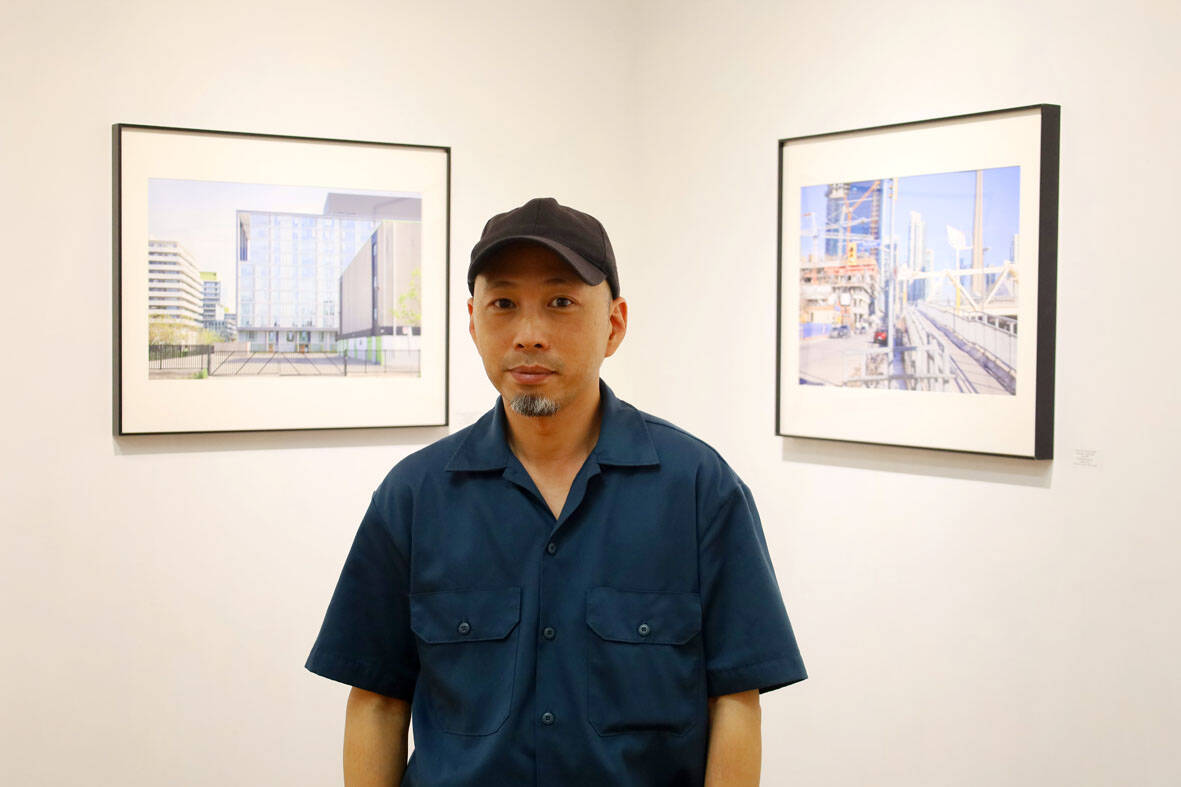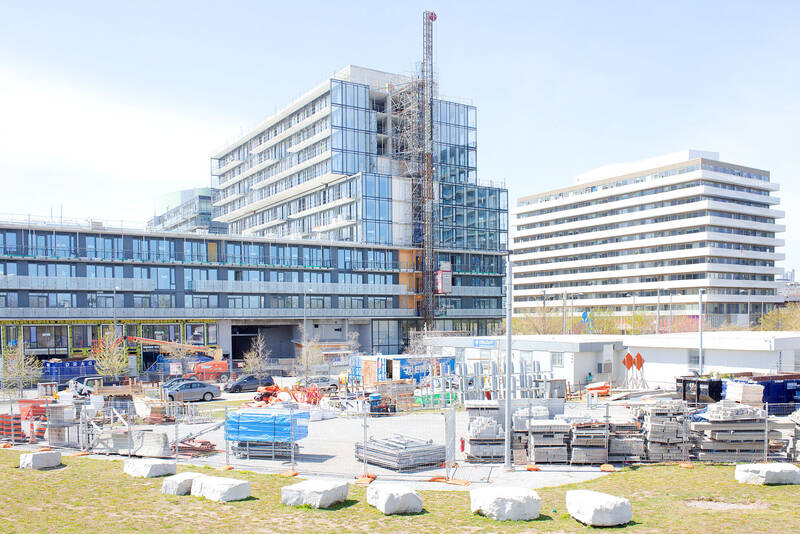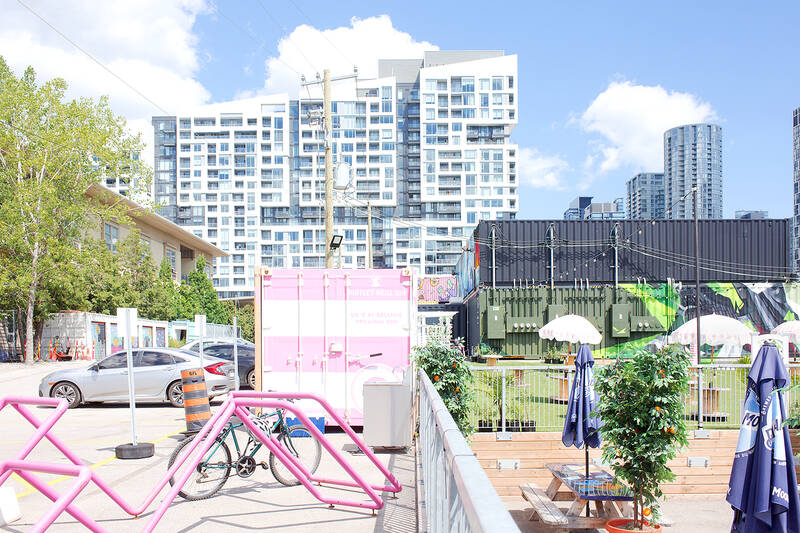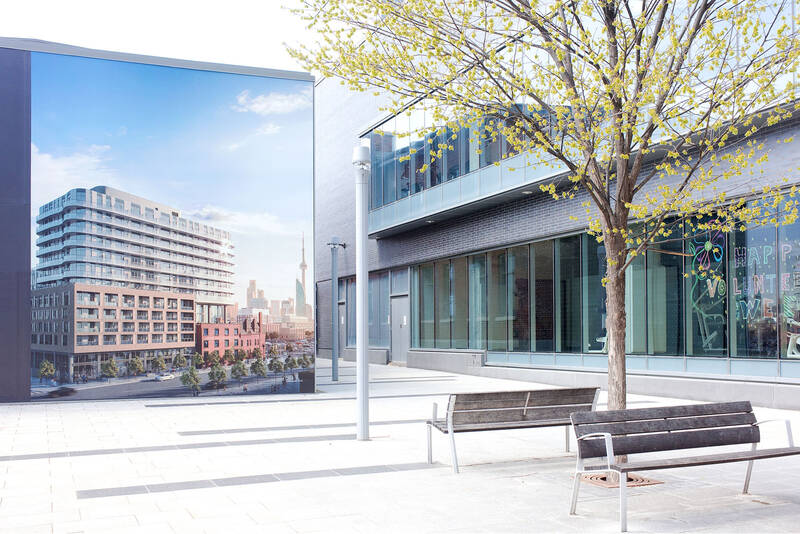Curated by Edward Chiu (邱奕堅), Two Kings is the first solo exhibition of Toronto-based photographer Pengkuei Ben Huang (黃鵬魁) to be held in the city of his birth. It officially opens today in Taipei’s 1839 Contemporary Gallery (1839 當代藝廊) in Daan District (大安).
The photos on show document the Kings Regeneration Planning Initiative, which was launched in Toronto, Canada in 1996 to reappropriate 400 acres of unused industrial land located in the southern portion of the downtown area by then-mayor Barbara Hall.
The result has transformed the cityscape, with futuristic condominiums and tech company offices becoming new landmarks in a place that had long been red brick, low-rise and blue-collar.

Photo: Thomas Bird, Taipei Times
Huang uses his camera to focus on buildings old and new, derelict or under construction, often situated right next to one another. But what his images also address are pressing social issues such as gentrification, lackluster restoration and income inequality. In a city, and country, with a chronic deficit in affordable homes, the artist raises some important questions.
Describing his work as “a visual reflection of a complex relationship between the need for urban growth and the desire to preserve the characteristics of the past in our modern cities,” Huang tells the Taipei Times, “I hope [Taipei] locals find that there is a common ground, that even though we live in a very different, separate part of the world, there are a lot of similar problems. I don’t think we will find all the solutions but we can at least start a discussion.”
To this end, from 2.30pm until 5pm today, the artist will be in the gallery to talk about his work and answer questions from curators, art critics and members of the public.

Photo courtesy Pengkuei Ben Huang
LOOKING BACK
“It’s a surprisingly big space,” Huang says as he walks around 1839’s basement gallery assessing his images ahead of the big opening. “You wouldn’t get such a large gallery dedicated to photography in downtown Tokyo, Toronto or any other big city,” he says, acutely aware how urban space in 2024 is at a premium globally.
Huang knows what he’s talking about as he’s certainly been around — by his own admission having lived “the life of an immigrant” who has trouble “staying in one place for too long.”

Photo courtesy Pengkuei Ben Huang
The son of an Indonesian-born Chinese father stuck in Taiwan due to the anti-Chinese policies of the repressive Suharto regime, and a mother from a military family that had fled from China to Taiwan in 1949, Huang’s wayfaring genes were inherited from both his parents.
“I grew up in what is now New Taipei City. When I was nine, we moved to the east side of Taipei and when I was 12 we moved to Jakarta, Indonesia where we stayed for a few years. Then my parents sent me to California to go to school.”
It was while studying for a degree in international politics that Huang discovered his passion for photography.

Photo courtesy Pengkuei Ben Huang
“I bought a disposable camera and took a trip around San Francisco. I used the whole film shooting the city.”
The experience inspired him to enroll in some photography classes.
“The course required me to buy an SLR camera for US$300. After that, I changed my major and my university. I thought, well, I’ve already invested this much, might as well just jump in.”
Huang became an enthusiastic shutterbug while studying at the Academy of Art University in San Francisco. He began to imagine for himself a future career in commercial photography or photojournalism, until a trip to Los Angeles changed his tack.
“I went to see the New Document exhibition, which featured the work of three highly influential American photographers Diane Arbus, Lee Friedlander and Garry Winogrand,” Huang says.
After witnessing the power of photography as creative tool, Huang’s camera was refocused on making contemporary art.
In 2005, Huang’s next move, after graduating with a BFA, was northward to Canada.
“I lived in Vancouver for three years just trying to figure things out. In 2007, I joined a workshop in Toronto organized by Magnum Photos. I was mentored by [photographer and poet] Larry Towell. He really liked my work Fantasyland, which I made about a theme park.”
The mentorship paid off — he was a finalists for The Scotiabank Prize, Fantasyland was published as a photobook and Huang began getting invited to exhibit his work. He relocated to Toronto, which he has made “a base” ever since, and where he is currently represented by Elaine Fleck Gallery. But it would take the pandemic before he would seriously train his lens on his adopted hometown.
A FACADE
“Since 2011, I’d been regularly travelling to and from Japan photographing the devastation of the Tsunami and how small towns have been recovering,” he tells the Taipei Times of a photo project called Coastal Mammoth: The Great Seawall of Japan.
When COVID-19 brought the curtain down on international travel, Huang began looking closer to home for a subject and found it along the Kings Street corridor (east and west), an area facing Toronto Harbor he says he’s passed through many times but never really looked at.
“The city’s chief planner Paul Bedford was influenced by urban theorist Jane Jacobs,” Huang says. “Under the initiative, the area was envisioned to be a thriving mixed-use community.”
The verdict is out on whether the scheme has been a success. It certainly has turned “an industrial wasteland” into a much sought-after piece of real estate. But there’s ongoing debate in Canada about the loss of old buildings, as well as the price of new housing that has replaced old waterfront warehouses and disused factories with glassy high-rises.
“Sometimes all they keep is the facade of a heritage building. They demolish it from the inside out,” Huang says. “And a one-bedroom condominium will cost about one million Canadian dollars [NT$23.8 million].”
Emboldened by the absence of people out on the street during the pandemic, Huang went out photographing in the middle of day — the white light and absence of shadows giving each image a stark, artificial, almost magazine-like quality.
“I do almost no post-production,” he says, proud of his minimalist stripes. “I took the experience from studying street photographers, of walking around and just shooting. But at the same time, I do remember in school we were required to actually work with the large format camera. So I also took that approach.”
The result is a series of images that illuminate “the city in transformation” as Huang puts it, as well as illustrating “a clash, or a fusion of the modern and the past.”

In the March 9 edition of the Taipei Times a piece by Ninon Godefroy ran with the headine “The quiet, gentle rhythm of Taiwan.” It started with the line “Taiwan is a small, humble place. There is no Eiffel Tower, no pyramids — no singular attraction that draws the world’s attention.” I laughed out loud at that. This was out of no disrespect for the author or the piece, which made some interesting analogies and good points about how both Din Tai Fung’s and Taiwan Semiconductor Manufacturing Co’s (TSMC, 台積電) meticulous attention to detail and quality are not quite up to

April 21 to April 27 Hsieh Er’s (謝娥) political fortunes were rising fast after she got out of jail and joined the Chinese Nationalist Party (KMT) in December 1945. Not only did she hold key positions in various committees, she was elected the only woman on the Taipei City Council and headed to Nanjing in 1946 as the sole Taiwanese female representative to the National Constituent Assembly. With the support of first lady Soong May-ling (宋美齡), she started the Taipei Women’s Association and Taiwan Provincial Women’s Association, where she

Chinese Nationalist Party (KMT) Chairman Eric Chu (朱立倫) hatched a bold plan to charge forward and seize the initiative when he held a protest in front of the Taipei City Prosecutors’ Office. Though risky, because illegal, its success would help tackle at least six problems facing both himself and the KMT. What he did not see coming was Taipei Mayor Chiang Wan-an (將萬安) tripping him up out of the gate. In spite of Chu being the most consequential and successful KMT chairman since the early 2010s — arguably saving the party from financial ruin and restoring its electoral viability —

It is one of the more remarkable facts of Taiwan history that it was never occupied or claimed by any of the numerous kingdoms of southern China — Han or otherwise — that lay just across the water from it. None of their brilliant ministers ever discovered that Taiwan was a “core interest” of the state whose annexation was “inevitable.” As Paul Kua notes in an excellent monograph laying out how the Portuguese gave Taiwan the name “Formosa,” the first Europeans to express an interest in occupying Taiwan were the Spanish. Tonio Andrade in his seminal work, How Taiwan Became Chinese,